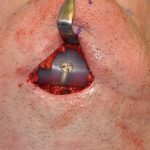1. How do I know a chin augmentation will make my face look better?

2. What are chin implants made of?
By far, most of the chin implants used are made of silicone rubber, also known as silastic. This inert material is one of the most biocompatible of allbiomnaterials, is made in dozens of different shapes and sizes, and is inexpensive. Other implant materials are also used of which Medpor (polyethylene) is the most well known. It is a porous plastic material that is stiffer (needs a bigger incision to insert)and more expensive. Rarely used are other materials including Gore-tex and Mersilene mesh.
Given these different implant options, patients often ask which one is best. While certain plastic surgeons may advocate one over the other, the body does not really see them as any different. The shape or type of chin implant used is by far more important than the material from it is made. Given that today’s implants can change numerous dimensions of the chin, one should focus on these change possibilities and how they may be aesthetically beneficial.
3. What is the best way to place a chin implant, through the mouth or from under the chin?

4. Will I be able to eat and drink right after surgery?
Yes. Since the chin implant is on the front end of the jaw bone (mandible),it is does not interfere with jaw movement or opening one’s mouth. It is also places no restriction on chewing or swallowing. If an incision is used from inside the mouth, I merely tell patients not to bite food off but to use utensils to bypass what your front teeth normally do When the incision is used from under the chin, there are no restrictions at all
.
5. I heard that the chin bone can be cut and moved forward (osteotomy) instead of an implant. Which is better?

In my Indianapolis plastic surgery practice, I use the following three indications for a chin osteotomy. A young patient, the need for significant horizontal advancement, and if one is undergoing facial bone movements (orthognathic surgery)at the same time. The value of a chin osteotomy is that it can avoid a large implant that must remain complication-free over a long patient life-time.
A chin osteotomy can also do one thing that an implant can not. It can lengthen the chin vertically. While minor amounts of vertical height increase can be obtained by a low position of an implant, significant lengthening requires an interpositional graft after the chin segment is brought downward.
6. Can a chin augmentation be done with other facial procedures at the same time?
Yes. In fact, most chin augmentation procedures are usually part of combination facial plastic surgery. Most commonly, chin enhancement is done with rhinoplasty in a young patient and with a facelift in older patients. It is also one of the procedures in the facial ‘trifecta’ for men…chin, cheek, and jaw angle augmentation.
7. If I play sports, will having a chin implant be a problem?

Dr. Barry Eppley
Indianapolis, Indiana


